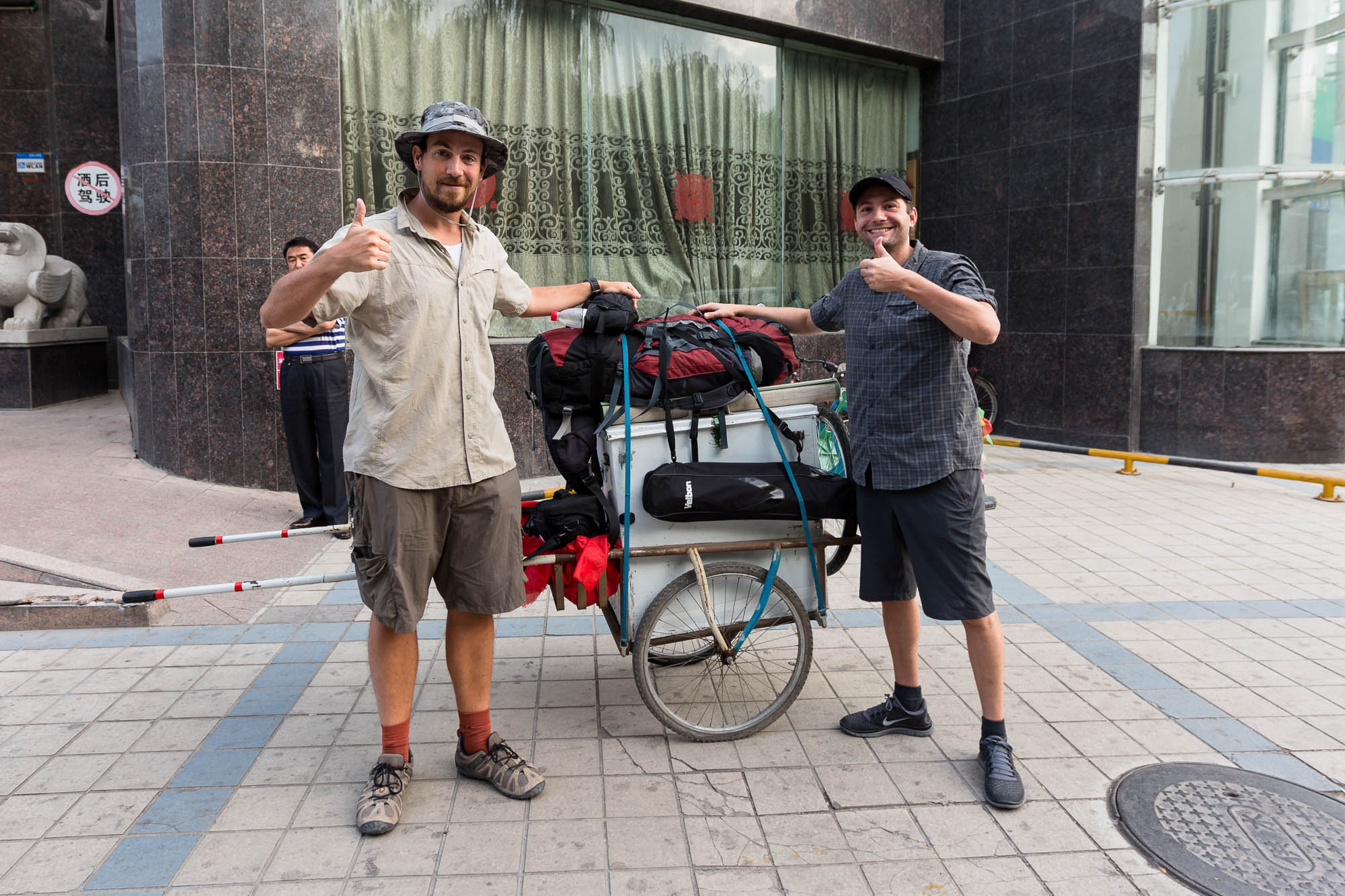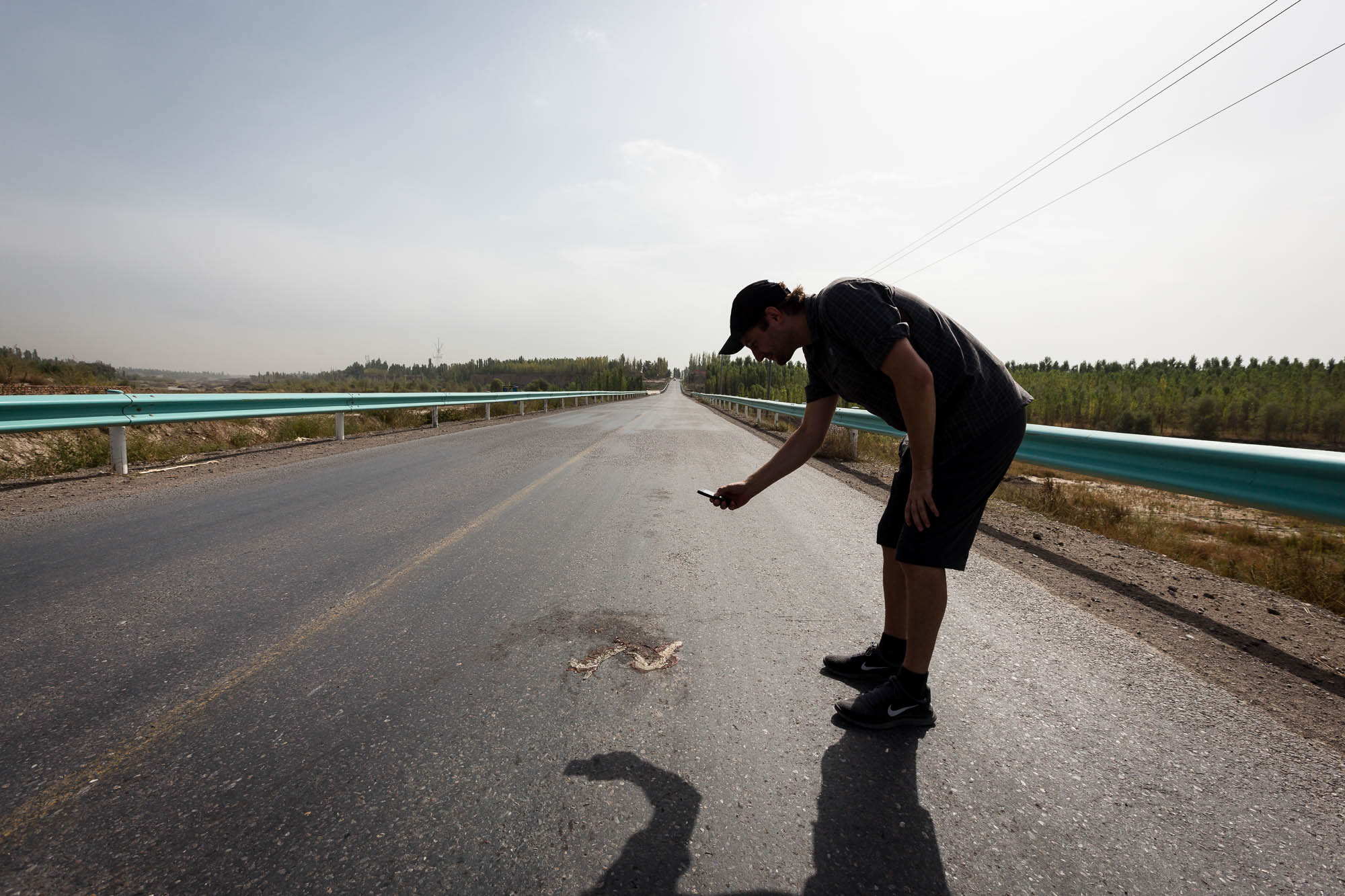corn snake
Today we started to walk. I was happy that the Caboose seemed to get along quite well with my good friend Dario:
(It would have been hard if I had to choose between them.)
We took a different way out of Yining, and we passed by something that looked old:
I’m saying that it “looked old”, because I don’t know much about these things, and I am easily fooled.
Then there were sunflowers:
We jumped around in them for a while:
Feeling that walking was good:
It was good because the road was ours:
…at least that’s what we thought until we saw the dead snake:
And the other one that was very much alive:
So was this snake country?
Well, not only that.
It was also corn country:
There was corn everywhere.
In fact there was so much of it on the roads, that sometimes the only thing we could do was walk right over it:
So is it fun to walk on corn?
From a walker’s perspective, I think corn makes for a mixed walking ground. While the crackling sounds are nice as hell, the surface is a bit too unstable and tends to shift under your feet. So I don’t recommend walking on corn for longer periods of time.
Anyway, we had lunch in a small Uyghur village:
And that’s where I had the honor of introducing Dario to one of the finest things in these lands:
Zamzam Cola. It’s a sort of Uyghur soft drink. I don’t know if it is in any way affiliated with the Iranian brand that goes by the same name. Anyway, it is very tasty!
We passed by some farm houses that could only be described as optimistic:
And that’s exactly where we ran into this guy:
Like a boss!
…
The rest of the way was nice and easy:
We passed green fields:
And more corn:
And rice plantations:
Then we reached Regiment 66, the place where I had stayed a few days ago on my way to Yining:
We got a room. For some reason, there was no electricity. And for some even more obscure reason, there was no running water either.
But we didn’t care. We punctured some blisters, then we had dinner.
Then we talked through the dark.















Neil Sandage
My friend you must really learn how to step in a straight line. I have hiked and trekked and never experienced NEAR DAILY blisters that you bravely power through. I know from experience that walking on gravel is different (generating hot spots) than walking on stone and earth on trails. But I have never gotten a blister from trekking along a paved road either. The trick about pavement is needing snug synthetic shoes that breaths with soles that have micro-foam-bubble layer so heat does not travel from pavement friction into the shoes (my foot shape prefers New Balance or Brooks). In dirt I prefer all leather (whatever fits comfortably and is gusseted up the tongue, I have water proofed many construction boots).
1. Perhaps you should change your socks every break or two to restore the cushioning to your feet. When it rains I change socks twice a day, on sweaty pavement perhaps you should do it more often?
2. I always wore insoles. Sometime the shoe maker had removable insoles so I didn’t have to buy them separately and could swap them out with those made by the original company.
3. Practice walking miles barefoot. Many runners swear by “Vibram 5 Finger” toe shoes. Christoph you roll your ankles out too much and seem to balance on the inside of your feet (would ice skating train you to balance through the center of your foot?).
When I was a kid they taught us how native Americans walked in a straight line through the woods. Great for running, but we must learn to step differently and change out gait (horse trot) according to the speed of travel and type of terrain. I learned this later, when as an adult I had an experience where I discovered why people “mosey” (The way people sore from sitting in a saddle walk, is really a knot in the hair under your groin sack causing discomfort) because my thighs and underside of my balls were chaffing from walking on paved roads home after dancing and sweating in jeans that were rubbing me wrong. Walking 5 miles home because I had been drinking and was too cheap for a taxi, meant shifting the hips forward and bowing legs into your step a little on the outside of your feet (instead of the inside), you walk a little lower and it gives your crotch space to breath. Remarkably my leg muscles felt like they had walk city blocks instead of miles by moseying like a saddle sore cowboy.
You have the spirit it takes to be a great adventurer and complete your journey. You need to learn more about walking and picking shoes designed for your “pronation of the feet” (how you step) so that you no longer suffer. I’ve done 30-50km walks through the Appalachian Trail Mountains everyday for a week and never had a blister. I honestly believe it is better to learn to walk differently than to buy shoes that support untrained rotation.
Please look into training how your feet touch and leave the ground. It’s like dancing. Once your feet learn a new way to move, you don’t have to think about it.
1. In the mountains I wear shoes that cover my ankles.
2. And despite what the pros endorse I always wear extra thick cotton socks. = Diabetic Socks are the best!
3. While I recommended above ankle leather boots, I know from my New Balance Men’s M3090 Athletic Running shoe how these very light street shoes feel much better when not carrying a load or pulling anything. They seem to wear down quickly. But they are the most comfortable shoes I have ever had and breath better than any other shoe, unfortunately water puddles and rain go straight to the sock.
You are the best suited person for this Journey. And it would be much easier for Christoph to complete it if he weren’t get foot blisters. I believe 90% of the blisters Christoph is getting are due to him learning to walk while wearing shoes and not learning from walking barefoot on different surfaces. Imagine never getting another Blister? I believe it is possible if Christoph learns more about barefoot running.